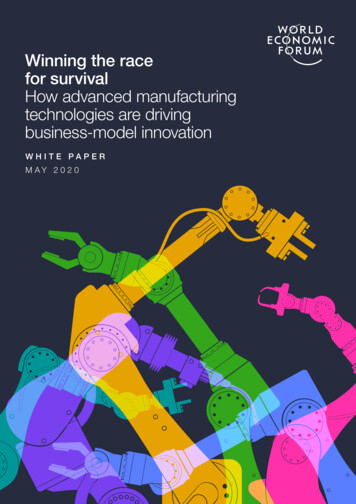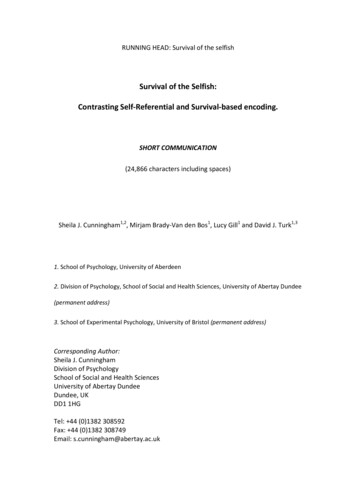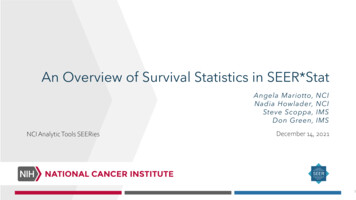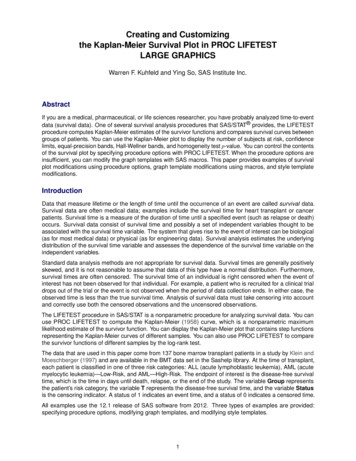
Transcription
Winning the racefor survivalHow advanced manufacturingtechnologies are drivingbusiness-model innovationWHITE PAPERM AY 2 0 2 0
To cite this paper, please use the following:Joglekar N., Parker G., and Srai J. S., (2020),Winning the race for survival: How advancedmanufacturing technologies are drivingbusiness-model innovation, https://papers.ssrn.com/sol3/papers.cfm?abstract id 3604242Contents3Overview51 A new business model conversation is urgentlyneeded right now72 O perating vs business model93 F ailures in operating and business models duringthe COVID-19 crisis134 S uccesses in operating and business models duringthe COVID-19 crisis175 A call for action: Towards a new normal for advancedmanufacturing, services and supply chains18Acknowledgements 2020 World Economic Forum. All rightsreserved. No part of this publication maybe reproduced or transmitted in any formor by any means, including photocopyingand recording, or by any informationstorage and retrieval system.2Winning the race for survival
May 2020Winning the racefor survivalOverviewThe current pandemic is liberatingmanufacturing and production companiesto experiment with radical new ideas.Firms are coming up with new ways to keep makingexisting products despite disrupted supply chains, or,as demand for existing products collapses, designnew ones.–Would firms quickly return to “business as usual”or would they examine what worked (and whatdidn’t) during this period of “mass experimentationat scale”?With revenues falling for almost all firms, companiesare doing everything in their power to preservecash reserves – and this has allowed some firms todiscover new ways to do things differently withoutlarge investments.–Would the resilience achieved today only be madepossible through super-human efforts justifiedby being in ‘crisis’ mode, and not sustainable in‘normal’ mode of working?–Will only the handful of ‘superstar’ firms and getstronger yet and more dominant in manufacturing?As most manufacturing firms continue to realize theirrevenues through traditional channels, the disruptionbrought by the pandemic has created the need forrapid and radical innovation in both operating andbusiness models.In this context, we have been working with theAdvanced Manufacturing and Production communityat the World Economic Forum to try to to try to answersome of these questions.The future belongs to those who are able to manageuncertainty and innovate rapidly. Firms that emergefrom the pandemic disruption will have some choicesto make.To make sure we stay relevant in this fast-changingenvironment, we will be publishing our work in threedifferent releases:–What is the role of advanced manufacturing andproduction technologies in shaping new operatingand business models?1.Sinking, swimming or sinking: perspectives onoperating and business models (current paper)2.–What are the operating and business modelinnovations worth keeping once the crisis willbe over?Accelerating business models innovation (to bepublished)3.Transforming industries at scale (to be published)Winning the race for survival 3
Release 1Sinking, swimming or surfing:Perspectives on operating andbusiness modelsSummaryThe shock brought by the pandemic is liberating firmsto make numerous experiments. Some will fail, whileothers will succeed. This creates a tipping point for along overdue conversation about new business modelsin advanced manufacturing and supply chains. Asorganizations settle into either a new normal or plan theirreturn to pre-pandemic operations, the question arisesas to whether firms will “snap back” to normal or settleon some new equilibrium. We may be on the precipiceof “Operational Darwinism”, wherein mere reductions incosts may not be enough to compete against leaderswho make manufacturing a rapid and key part of theirdigital innovation edge. In this paper, we explore what newbusiness models might look like and how they are likely tointeract with both existing operating models in the contextof the new normal brought about by the pandemic.RELEASE 3Transformingindustries at scaleRELEASE 2Acceleratingbusiness modelsinnovationRELEASE 1Sinking,swimming orsurfing: Perspectiveson Operating &Business Models4Winning the race for survival
1A new businessmodel conversationis urgently neededright nowLess innovative firms will be left behind1.1 The race for survival will spark innovationWe have alsowitnessed leadersbringing rapidand dramaticchange withoutmaking additionalinvestmentsthrough strategicmeasures such asinnovating theiroperating andbusiness modelsThe shock brought by the pandemic is liberatingfirms to make numerous experiments. Some willfail, while others will succeed. This creates a tippingpoint for a long overdue conversation about newbusiness models in advanced manufacturing. In thepast decade many firms have made significant effortsto digitize their factories and optimize their supplychains but, for the most part, these firms have yet tofully embrace different ways to monetize and capturevalue from their operations.The pandemic has thrown some of these firms intochaos by shutting them down or overwhelming themwith demand they cannot meet, while disruptingtheir supply chains, forcing change that was oncedeemed unimaginable. On the one hand, some firmsare adapting to the COVID-19 crisis with tacticalmeasures such as cutting costs, reshoring parts ofproduction and diversifying suppliers. On the otherhand, we have also witnessed leaders bringing rapidand dramatic change without making additionalinvestments through strategic measures such asinnovating their operating and business models,reconfiguring existing technology to remotely managetheir infrastructure and enabling digital collaborationacross the value chain end-to-end.As organizations settle into either a new normal or plantheir return to pre-pandemic operations, the questionrises as to whether firms will “snap back” to normalor settle on some new equilibrium. We may be on theprecipice of “Operational Darwinism”, wherein merereductions in costs may not be enough to competeagainst leaders who make manufacturing a rapid andkey part of their digital innovation edge. In this whitepaper series, we explore what new business modelsmight look like and how they are likely to interactwith both existing operating and business models inthe context of the new normal brought about by thepandemic. Our findings and conclusions are the resultof consultation and collaboration with senior executivesfrom discrete assembly manufacturing companies,process manufacturing industries, financial servicesand the software sector.Winning the race for survival 5
1.2 Digitization is setting the stage for changeThe COVID-19 pandemic has only accelerated whatwe have observed to be a megatrend in the globaleconomy. Major digital technology firms such asAlibaba, Amazon, Google, Tencent and many morehave grown far faster than the financial servicesand energy firms that once dominated global equitymarkets. Such a rapid growth has been driven byimprovements in information and communicationstechnology (ICT) and a dramatic increase in theability to capture, process and transmit information.However, the ability to capture and processinformation is only a necessary but not sufficientcondition for new firms and industries to arise.In fact, the fastest-growing firms are those that notonly harness information but also possess an abilityto transform it into valuable products and services.Information has the characteristic that, once created,can be distributed at very low cost, which changes thecost structure of firms on the supply side.This disruption can be compared to the transformationof the industrial economy that allowed for the giantsteel, transportation and energy firms to grow at scalein the 1900s. What is different at this point in historyis that many of the largest firms also harness networkeffects whereby incremental value is created as afunction of additional users who create value for oneanother. This creates what is called a “demand-sideeconomy of scale” that tends to create a positivefeedback loop such that the leading firms grow evenmore quickly.1.3 Manufacturing companies are trying to adaptManufacturing companies have noticed megatrends– from digitization to the imperative of environmentalsustainability and globalization – and have beguninvesting in projects that exploit data. Some haveseen early success. For example, many of the fastestgrowing parts of industrial firms such as Siemensand John Deere are their software and informationservices arms. John Deere created a digital serviceslayer to help farmers better utilize seeds and fertilizersas well as to capture data that reduces equipmentoperating and maintenance expenses. Going beyondthe relatively straightforward cost-focused approachto using data are firms that add digital services layersto extend system functionality. For example, Siemenshas added AI-driven diagnostics to its medicalequipment that can be provided by either the firmitself or by partners through its Healthineers DigitalEcosystem Platform. Numerous firms have launchedinitiatives to explore new business models as part oftheir digitization initiatives. However, many firms findthemselves stuck in “pilot purgatory” as they work totransition these initiatives to self-sustaining businesses.Digitization efforts often change business models,and create new sales channels, both of which disruptexisting parts of organizations.1.4 Less innovative firms will be left behindThe firmsbest-positionedto adapt quicklyto disruptionare those thatcan digitally linktheir design andoperations allthe way to themanufacturingfloor to createseamlesscustomersexperience.6Winning the race for survivalThe urgency of the business model conversation isaccelerated by the extreme disruption caused bythe pandemic. The current situation has createdan avalanche of change where the pace has beenmore glacial. In fact, existing supply chains havecollapsed at the same time that firms are experiencingdemand disappearing or expanding dramatically. Thisunprecedented scenario has created the need forrapid and radical actions.Most manufacturing firms continue to realize theirrevenues through traditional channels (e.g., the saleof their primary products, services and after-marketsales of services and supplies).By contrast, Amazon Marketplace is able to morefluidly connect supply and demand. Other firmsstruggle because, although manufacturing firmsparticipate in markets, they are less likely to have themanagerial capabilities to manage markets that matchsupply and demand and, as a result, are less able todo so on short notice.The current crisis, which has depleted cash reservesand the ability to invest at most firms, is creating theperfect space for new entrants that utilize differentbusiness models, especially market orchestration, toemerge and is allowing for companies that leverageICT to rise even faster.The firms best-positioned to adapt quickly todisruption are those that can digitally link their designand operations all the way to the manufacturing floorto create seamless customers experience.Those manufacturing companies that do not innovateat speed by reconfiguring their supply chain in the faceof change are at risk of being left behind.
2Operating vsbusiness modelThe lines between operatingand business models are blurring2.1 Understanding the difference betweenoperating and business modelsAlthough operating and business models are tightlyinterconnected and mutually reinforcing, they embodyvery different concepts, so it is useful to make adistinction between them.––Operating model: How an organizationcreates value. By operating model, we meanthe value (in a product or service) that anorganization creates, the locations where valueadding work is done, the information systems thatsupport operations, the supplier network and themanagement systems that coordinate the overallvalue chain.Business model: How an organization capturesand delivers value By contrast, the businessmodel is the way an organization realizes revenues(and profit or loss for profit-oriented businesses) bycapturing and delivering value to customers.Business model examplesThere are different ways in which organizationscapture and deliver a part of the value created by theoperating model.1. Linear value chain: A standard business modelconstitutes taking full responsibility for the valuechain, delivering a product/service to an end-stageor intermediate customer and profiting by producingthe product/service at a lower cost than the pricethe firm charges. Products such as consumerpackaged goods fit into this category. Durablegoods such as capital equipment also fit thedefinition with the caveat that many organizationssuch as Rolls-Royce Aerospace rely on servicerevenues from their installed base to be profitable.2. Making markets: A market arrangement existswhen an organization helps (at least) two externalparties complete a transaction and profits bytaking a percentage of the complete transaction.Similarly, an organization may facilitate transactionsamong external parties for a fixed fee. AmazonMarketplace and eBay exemplify this type ofbusiness model.3. Enhanced access: A third arrangement is where anorganization may facilitate access by one group toanother for some kind of fee (advertising revenuemodels would fit in this category). In addition to wellknown ad-sponsored platforms such as Facebook,Google Search, YouTube and Twitter, additionalexamples include LinkedIn, which charges additionalfees for enhanced access to users.Winning the race for survival 7
FIGURE 1Coupling of operating and business models2.2 The lines between operating and businessmodels are blurringManufacturing and supply chains have become oneof the most information-rich sectors in the past 10years. However, much of the data has been kept inisolation as back-end know-how. Operating modelsthat are highly digitized and leverage data to connectthrough to the end user become integrated with theirbusiness models, allowing them to better scale up.As an example, FastRadius, a company that is part ofthe Forum’s Global Lighthouse Network, is providinga complete solution, which extends through the enduser marrying the demand to the execution, referredto as digital thread. At FastRadius, validated design,manufacturing and supply chain entities are availableon the cloud (operating model) and can be readilyaccessible (business model) by physical entitiesthrough solutions such as additive manufacturing andUBS’s Worldport.Another example comes from leveraging existing lowcost digital data and infrastructure. Firms that leveragedigital platforms as part of their operating model,such as the ones provided by the manufacturingtechnology company Tulip, can have direct visibilityof their production capability and operations, and canalso monitor their products through Internet of Thingssensors once they reach the end users. This allowsfirms to reinforce and fashion their business model(e.g., lifecycle-based warrantee pricing) by leveragingexisting low-cost digital data and infrastructure.2.3 The imperative for business models innovationBusiness models are likely to be disrupted during timesof value-chain reconfiguration because of economiccrisis or other externalities, such as COVID-19. Inmany industries, operating models have built up overmany years and include stable relationships amongvalue-chain partners. This allows firms to developstrong partnerships and deep sources of technicalcapability. During times of disruption, however, thosestable relationships may collapse in the face of a lossof demand and/or supply. Conversely, there maybe large increases in demand that can also placesignificant stress on existing arrangements. In orderto effectively respond to disruption, firms may need to8Winning the race for survivalrapidly reconfigure their operating models in speed ofresponse, location of activities and identities of supplychain participants. Traditional value-capture modelswhere organizations take responsibility for largeportions of the value chain may find themselves underattack from entrants that rely on different businessmodels, especially market-based models which, bytheir very nature, are more fluid in the identity of theparticipants. Hence, it is important for organizationsto be clear about their current operating and businessmodels, how they reinforce one another and whatmight change during times of disruption.
3Failures in operating andbusiness models duringthe COVID-19 crisisThe COVID-19 shock reveals whetherunderlying business and operating modelsare robust or whether they will failFIGURE 2Failure modes during the COVID-19 crisis.Four dimensions of unanticipated outcomes and their driversAs we have seen in the previous sections, operatingmodels and business models may have manycomponents (e.g., a business model such as one-timesale may be enabled by job-shop production basedon the reconfiguration of 3D-printing line). For highperformance, these components must work togetherin a cohesive way. A crisis such as COVID-19 shocksall the components of operating and business models,and such shocks typically create extreme conditionsand reveal whether underlying business and operatingmodels are either robust or whether they fail undersuch stress.Winning the race for survival 9
3.1 The four modes of failureEven if there is still a lot of uncertainty and lack ofreliable information on how the current crisis willevolve, we categorized observed failures under fourmodes of unanticipated outcomes: (1) demand andsupply imbalance; (2) inflexible human resourcesand organizational processes; (3) constrained capitaland venture capital; and (4) rigid integrative systems.Underlying driving factors are described below inisolation for ease of explication. We note that systemicfailures have typically cascaded across these modesrapidly. Our assessment explores whether observedfailures can be ascribed to shortcomings either in thebusiness model, or with the operating model.1. Demand and supply imbalanceA number of ourindustrial partnershave reportedCOVID-19-drivensupply delaysranging from 1.5Xto 5X normal leadtimes to get thesuppliesIt is not useful to think about demand and supply inisolation. That is, a business, even if it experienced ademand surge owing to COVID-19, might fail if it cannotscale and satisfy demand. We characterize the demandand supply imbalance in terms of three separate,but related, drivers: significant supply chain delays;stockouts and hoarding; and shifts in consumption.Significant supply chain delays. A number of ourindustrial partners have reported COVID-19-drivensupply delays ranging from 1.5X to 5X normal leadtimes to get the supplies. In general, global supplychains, especially those involving maritime logistics,displayed the largest delays. Much of these delaysare because the volume of air shipments has beenreduced and even when goods are available (e.g.,from factories in mainland China). Ports have beenclogged, and bulk and container shipping routeshave been delayed as crew and support systemshave been exposed to COVID-19 and cannot get thepersonnel replacements and provisions needed forrapid turnarounds.Stockouts and hoarding. Independent of shippingdelays, the demand for select items (like toiletpaper) has been subject to hoarding and panic.Hoarding creates shortages and swings in demandand demand-supply mismatch at each stage of thesupply chain because of the bullwhip effect. Someretailers have resorted to rationing, but with longlead times at each stage of the supply chain, suchrationing has not always worked as evidenced byreported shortages. In addition, solutions, such asrationing, may not fit all business models: someof the higher-end retailers in the United States, forinstance, have discontinued price discounting whenfaced with shortages, while lower-end retailershave accessed local suppliers and cooperatives tomanage their demand and supply mismatch.Shifts in consumption. A third leading factordriving the imbalance is a shift in consumption.For instance, social distancing has shut down thedemand for restaurants (except for takeout orders)while creating additional demand for items suchas baking goods for home use, and for vegetableseeds for home gardens, which have also resulted instockouts and long waits.In our interviews, the origins of both hoarding and shiftsin demands were attributed to consumer behaviour(e.g., panic) and related actions. These consumeractions and resulting shortages were compoundedby long delays. Long delays are largely caused bydecisions associated with operating models, such singlesourcing. dAn example comes form the configurationof supply chains for items such as personal protectiveequipment (PPE) and masks. These delays are likely toeither persist for months or rear their head periodically.Such phenomena are exacerbated by both the rigidityin the operating models (e.g., inability to find secondsources rapidly) and the inability to adjust the businessmodel (e.g., systematic and rapid changes in prices inface of a shortage).2. Inflexible human resources and organizational processesA second major source of failures during COVID-19 hasbeen associated with HR and organizational processes.We characterize these types of failures in terms of threeseparate but related drivers: lack of collaboration andleadership; widespread infections leading to sicknessand absence; and overwork and furloughs.Lack of collaboration and leadership. A key reasonfor lack of collaboration has been interorganizationalprocesses that involve coordination acrossboundaries. Examples included supplies for PPEsbeing directed towards a single country instead10Winning the race for survivalof sharing proportionally across multiple affectedcountries. Bidding for items such as test kits hascreated infighting and finger pointing between thefederal government and states in the US. Oftenthere is an element of incentive incompatibility inthe underlying business models, whereby individualactors deem interorganizational collaboration as azero-sum game. Such problems highlight the clearneed for higher level coordination (federal and global).Lack of leadership is also evident in continuedreliance on existing information systems, such as datafor ordering processes and oversight of workforce
health, while it is apparent that systems have beenhardwired for maintaining the status quo rather thanfor the needed responses.Widespread infections leading to sickness andabsence. A second source of failure is the possibilityof infections in each link of the manufacturing andsupply chain infrastructure simultaneously. We haveseen large-scale meat production capacity – e.g.,at firms like Tyson foods – and distribution beingcompromised simultaneously because productionprocesses could not ensure distancing, and frontlineworkers in grocery store have faced infectionpossibilities because of frequent interactions withfellow workers and customers.Overwork and furloughs. Sickness and the resultingloss of capacity usually lead to overwork. This hasbeen especially acute in sectors such as healthcarebut is also seen in some sectors of the logisticssystem, especially those parts that are providingcritical supplies. Both the healthcare and the retailsectors have also been forced to furlough someof their workforce (such as the personnel who doelective surgeries).In our interviews, failures in HR practices (e.g., furloughs)were typically associated with business models thatpromoted the hiring of specialized labour. Similarly, alack of collaboration was often associated with the setup of the business model incentives rather than the waythe operating model was executed. Sickness and lossof capacity could be countered with buffers, but onlyif the operating model had built-in slack and flexibility.In the reported failures we have seen, the operatingsystem lacked such buffers.3. Constrained capital and venture capitalmanufacturinginfrastructure hasonly accounted forapproximately athird of the entirecapital stockWe have identified three drivers of capital-relatedfailures: lack of liquidity; inflexible healthcaretechnologies; and leaning of shop-floor/supply-chaintechnologies. It is worth noting that manufacturinginfrastructure has only accounted for approximatelya third of the entire capital stock (even in the US,the remaining investment has gone to sectors suchas services). This underinvestment is becausemanufacturing and supply chains are not seen as keydrivers of innovation. The flow of venture capital into thesector has also been relatively weak as compared toother digital infrastructures.Lack of liquidity. COVID-19 shortages and shiftsin demands have reduced revenues. This hasaffected low-margin business models, such as inthe retail sector, especially for small and mediumsize enterprises. This lack of liquidity has in turncreated pressure to reduce fixed costs (see furloughs,discussed above) and to reduce variable costs byreducing orders, which have created liquidity pressureon upstream manufacturing firms.Inflexible healthcare technologies. Independentof the liquidity crisis, a second source of failure is thelack of investment in flexible service technologies,particularly in the healthcare sector. Businessmodels in this sector have been myopic, resultingin a lack of buffers for PPE. Such business models,both at individual firms and at national levels, haveunderinvested in R&D and it will take a very long timefor their innovation and production systems to invent,produce and distribute critical supplies such assuitable vaccines, when demand goes into billions, forCOVID-19 prevention and cure.Leaning of shop-floor/supply-chain technologies.A third dimension of capital-driven failure hasbeen operating models that shape investments inproduction shop-floor and supply-chain technologies.Implementation of these technologies, such as factoryrobots at automotive and pharmaceutical firms,has been based on lean production principles thatare designed to optimize “just in time” inventoriesand to reduce variable costs. In doing so, theseoperating models may have over-emphasized “justin time” while underinvesting in “just in case” and theflexible production capacity that is so clearly neededduring the COVID-19 crisis and which would be oftremendous benefit in future disruptions that arenearly certain to take place because of megatrendssuch as climate change.4. Rigid integrative systemsIn addition to components such as HR and capital,large systems draw on integrative systems to ensurethese functions work cohesively as a system. Driversfor a final set of failures, which we label as integrativefailures, may be grouped into: knowledge gaps,inflexible platforms and hierarchies; restrictive legalregimens; and unreliable information systems.Knowledge gaps, inflexible platforms andhierarchies. We have witnessed systemic failuresin platforms that have the governing rights and animplicit responsibility to protect the interests of theirsupply and consumption networks. Some platforms(such as Alibaba) have helped their suppliers thatfaced liquidity issues. Others, including firms such asAmazon, have elected not to do so. OrganizationsWinning the race for survival 11
with flat structures, such as some big box retailersin the UK, have also been slow to pick up trends indemands and have faced stock-outs. Many multilayered entities have faced distortions in demandand-supply signals that are amplified by knowledgeuncertainties, wherein manufacturers and supplierseither do not have access to real-time data or lackthe knowledge to ask the right questions. Tighterhierarchies, such as Asian grocery chains in theUK, have leveraged formal and informal networksat multiple levels to detect trends early and havebeen able to address knowledge gaps at multiplelevels (retail, distributor and shipping) through rapidcycles of informal feedback on the demand, pricingand lead times. This speaks to need for resiliencemultiple levels in business and operating models.Restrictive legal regimens. Legal regimens affectthe manner in which operating and business modelsget set up. The COVID-19 crisis has created needsthat have changed some regulations. For instance,trucking laws in the US have been relaxed to removerestrictions on contiguous hours worked. Althoughthis increases capacity in the near term, therelaxation has also resulted in increased workloadand mounting safety concerns, with the possibility ofa loss of capacity in the mid and long term. Similarly,there are restrictions in several countries on specific12Winning the race for survivaltrades such as construction work and seasonalfertilization of gardens because they are deemedas “non-essential work” based on distancingrequirements. This creates production failures thatwill last for months or for an entire year’s work cycle.It has also fostered a sense of inequity and new legalregimens may have to evolve to assess which workis deemed essential in a fair and consistent manner.Unreliable information systems. In manyinstances, individual firms have rapidly flipped theiroperating models and have implemented Buy OnlinePickup In Store (BOPIS) practices. In our interviews,we have been told about shifts in the demand fromconventional retail to BOPIS by a factor of five ormore. The lack of reliable information and continueduncertainties are the key issues here. Many ofthese firms had to take on the herculean task ofdismantling their existing operating models, suchas bypassing ordering heuristics that are hardwiredinto their information systems. For example, insteadof making decisions based on orders seen at thestore level, these firms had to switch decisionsbased on online orders. Whether this shift will lead topermanent changes in consumer preferences and inturn require a change in underlying business modelsis an open question.
4Successes in operatinga
2 Winning the race for survival Contents Overview 1 A new business model conversation is urgently needed right now 2 Operating vs business model 3 Failures in operating and business models during the COVID-19 crisis 4 Successes in operating and business models during the COVID-19 crisis 5 A call for action: Towards a new normal for advanced








![[ST] Survival Analysis - Stata](/img/33/st.jpg)

